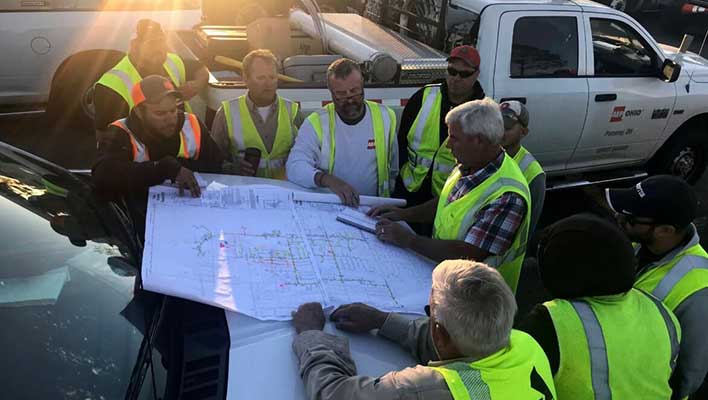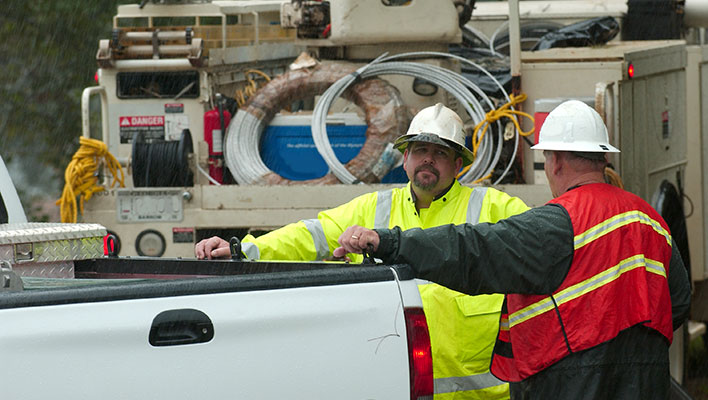Chris McClain is engineering supervisor at Southern Company and is an advocate for helping the electric transmission and distribution industry advance power restoration by leveraging technology to seamlessly manage damage assessment and repair. Bringing insights from the front lines of digital utility transformation, his blog series walks readers through the journey from managing mountains of paper feeder maps to mobile workforce management and power restoration in one of the country’s frequent storm hotspots.
Mutual assistance is one of the things I love most about working in power transmission and distribution. Whether you’re a large utility on the east coast or a cooperative on the west coast, our community of engineers and line workers have the same goal – safely getting the lights back on as fast as possible. Hospitals, nursing homes, police, fire departments, and other critical services urgently depend on damage assessment and repair teams following a severe weather event and outage. And in many parts of the country, residential customers can face life-threatening situations during triple digit summer temperatures or icy conditions in places that don’t normally see extended freezes.
I can’t think of any other sector where teams call on each other for assistance like we do (you would never see one airline call on other airlines to lend thousands of their workers when they suddenly have a crew shortage responsible for cancelling thousands of flights). Thousands of mutual assistance line workers routinely show up to help restore power following major storm events like hurricanes and tornadoes.
In this blog series I am simply attempting to share insights and lessons learned from our digital transformation experiences as we’ve worked to further streamline storm restoration and advance the mission of safely and quickly getting customers energized. Going paperless with digital feeder maps, nurturing digital transformation among field workers, and partnering with key vendors to scale mobile workforce management are three keys to success. Today, I’d like to explore the fourth key – empowering mutual assistance crews with mobile technology to seamlessly orchestrate storm response.
Building back the grid following a major outage event often requires thousands upon thousands of evaluators and line crew resources. Managing even a small number of non-native crews is a daunting effort with pervasive challenges, including:
- Creation of crew rosters and patrol assignments across many non-native organizations.
- Communication with large numbers of line workers before and during storm response.
- Coordination of lodging and food service for hundreds or thousands at a time.
- Training non-native crews on your unique system and navigating them to the correct sites.
- Securing data and ensuring non-native resources have access to the circuit information they need.
When it comes to securing resources, the bulk of the work is done via preliminary mutual assistance conference calls and the Resource Allocation Management Program for Utility Personnel (RAMP-UP) system. Once they’ve all been allocated, the impacted utilities are then left with managing all of these inbound non-native resources. And while the logistical challenges of lodging, feeding, etc. are critical, we are focusing here on the work-related challenges that we have been working so hard to overcome.
We first developed a method for batch importing and auto-creating users in ARCOS Mobile Workbench. But just like you would never hand out the password to your home wi-fi network to the entire neighborhood, we had worked with ARCOS to ensure the following requirements in Mobile Workbench:
- All users (full time employees + native contractors and non-native crews) are assigned a role that determines exactly what circuits each user has access to.
- To ensure a lightweight app and reduce network load, the app only fetches the bare minimum number of attributes related to a circuit, which combined with role-based circuit assignments reduce the data being transferred from 20+ gigabytes to a few hundred kilobytes.
- Cellular networks are also prone to storm damage, so it is essential that the app continues to function fully in an offline mode then automatically send damage assessments once a signal is established.
- The ability to link thousands of temporary users to a storm event then bulk revoke their access once they are released from our system.
With these measures in place, users that are created from this process are then sent a simple e-mail directing them to download the ARCOS Mobile Workbench app and install it on their mobile device. The e-mail also includes a 1-page PDF attachment as well as a link to a training video on the mobile app and our system to accelerate storm restoration readiness. And from that moment until they are released from their damage assessment and repair assignments, we are in constant communication with each user, know their exact position as they travel, and can begin assigning specific patrols as they arrive. Because Mobile Workbench is integrated with our OMS, managing crew assignments and changing them on the fly is completely automated and seamless.
Mobile Workforce Management solutions like Mobile Workbench provide one dashboard for remote operations teams to see and report, a single pane of glass through which to manage complex, continuously evolving storm restoration. Mobile Workbench is part of our overall strategy for restoring power safely and efficiently with its ability to perform quick and easy damage collection. Notes and patrol status are instantly sent back to our OMS instead of waiting until the end of the day for crews to return with handwritten assessments, enabling assets to be repaired faster than ever.
In my next blog I’ll bring this series to a close by exploring “the prize” for power distribution teams when they’ve successfully embarked on their own mobile workforce management journey and how crews are reaping the rewards in terms of greater optionality. Stay tuned!
Did you enjoy Chris’s blog? Check out his previous post: 5 Keys to Advance Power Restoration: Innovation is a Team Sport




